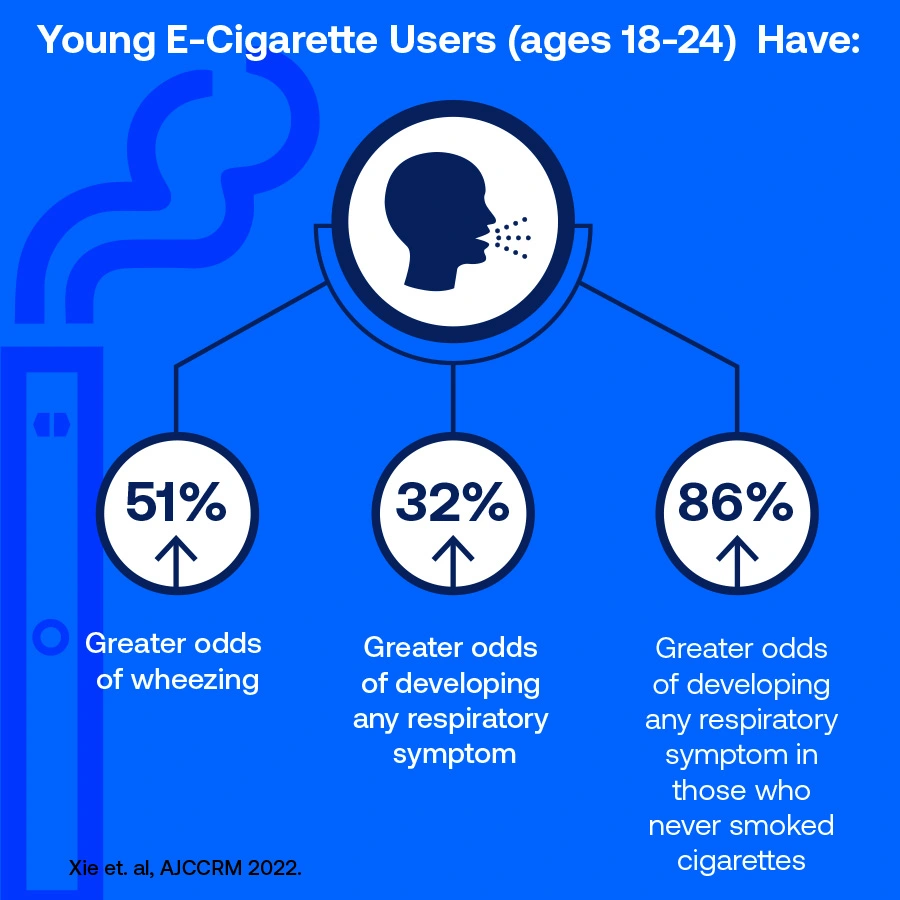Youth e-cigarette use is at alarming levels in the U.S. According to the 2021 National Youth Tobacco Survey, more than 2 million middle and high school students report current use, yet many of the respondents felt like there was little to no harm from e-cigarette use. Manufacturers of e-cigarettes specifically target kids with flavors that appeal to youth. While previous studies in adults show that e-cigarette use causes significant health risks, there is an emerging body of research in youth vaping which is following the same trend.
A recent publication in the American Journal of Respiratory and Critical Care Medicine provides some troubling evidence that young users (aged 18-24 years) of e-cigarettes are experiencing negative health effects. This article used data from the PATH study (Population Assessment of Tobacco and Health), which is a longitudinal study tracking changes in tobacco use over time among participants.
The main finding was that participants who used e-cigarettes reported respiratory symptoms including wheezing in the chest, difficulty breathing during exercise, and coughing at night. Diving a little deeper, former e-cigarette users (those who used e-cigarettes in the last 12 months but stopped) had 20% greater odds of developing any respiratory symptom, and 41% greater odds of developing wheezing in the chest. Those who continued to use e-cigarettes throughout the study period appeared to be at greater risk: 32% greater odds of any respiratory symptom, and 51% greater odds of developing wheezing in the chest. While this study did not focus on changes in symptoms after quitting, these numbers certainly show that quitting e-cigarette use cut risks.
E-Cigarette Flavors and Type of Device
While they examined any potential confounding effects of e-cigarette flavoring on respiratory symptoms, the study’s authors did not find a significantly higher incidence of any respiratory symptoms with flavors other than tobacco compared to never users. Notably, tobacco flavored e-cigarette users had 170% greater odds of developing any respiratory symptom (only 18 reported), and users of cartridge-based devices (like Juul) had 136% greater odds of developing any respiratory symptom compared to never users, which appears to be worse than users of disposable or tank-based devices. It is important though to note that this study was not designed specifically to examine flavors and may be underpowered to find these differences. Future studies will be conducted to address the effects of specific flavors and e-cig devices and risks.
Why it matters, and what can we do about it?
This study adds to the growing list of scientific data that shows that no e-cigarette is safe, and that younger e-cigarette users are at significant risk for lasting respiratory disease.
The Lung Association has called on the FDA to create a standard and define how many and which chemicals should go into an e-cigarette in order to be called “tobacco” The organization recognizes that all flavors in e-cigarettes are additives and there is no “tobacco” flavor inherent in e-cigarettes.
We also urge the FDA to take action to remove e-cigarettes and other tobacco products from the market that do not meet the public health standard. While the FDA issued marketing denial orders to over 320 companies, it has yet to take action on some of the e-cigarette products with the highest market share, including Juul, or any menthol e-cigarettes.
The American Lung Association continues to directly support publications such as this one. The senior author of this paper, Andrew Stokes, is currently funded by the American Lung Association Public Policy Research Award, a new award intended to examine public policy issues that impact lung health. Co-Author Panagis Galiatsatos is a national spokesperson for the Lung Association, and Hasmeena Kathuria serves as a scientific reviewer and is a former Lung Association grantee.
Blog last updated: October 24, 2025



